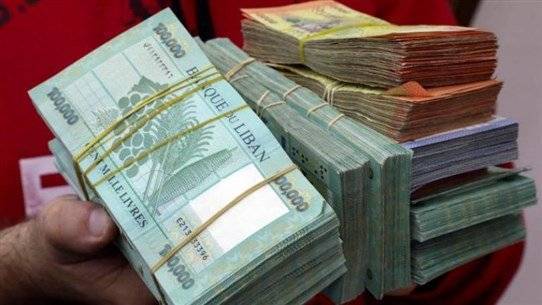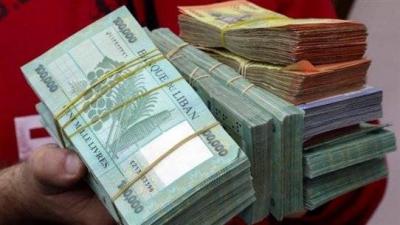Many Lebanese people, including financial and banking leaders, find it challenging to accurately interpret the implementation of the new official exchange rate for the lira against the US dollar starting November 1st. This ambiguity arises following the Finance Ministry's unexpected decision on Wednesday evening to reduce the rate by nearly tenfold, setting it at 15,000 lira instead of 1,500 lira per dollar. Just two hours later, the Ministry linked this adjustment to the approval of a government recovery plan.
The approaches to defining the effective date of the new official lira exchange rate are inconsistently contradictory, as are the estimates related to its consequences and implications. Meanwhile, the central bank has maintained a striking silence regarding the confusions that accompanied the decision and its subsequent clarification, despite its legal authority and mentioned partnership in the initial statement from the Finance Ministry. Informed sources confirmed that the Banque du Liban had previously approved the decision and participated in its formulation.
It is certain, according to monitoring banking sources, that significant and immediate transformations will occur within the monetary structure currently plagued by clear distortions due to multiple exchange rates. The actual exchange rate is determined solely by parallel and informal markets through applications commonly used by most Lebanese. Consequently, the substantial price disparities of the national currency necessitate the restructuring of the adopted official exchange rate, taking into account the deficits that have severely impacted revenues due to the lira's depreciation of nearly 95% and sharply rising inflation rates exceeding a cumulative 1,200%.
A senior banking official stated in a conversation with "Asharq Al-Awsat" that there is no escape from the gradual floatation of the lira, aligning it closer to the rate set on the "Sayrafa" platform managed by the central bank. Hence, the decision to reduce the official exchange rate to 15,000 lira per dollar after a month-long grace period can be understood as aimed at enabling state institutions and the private sector to efficiently handle its requirements and exemptions, particularly regarding previous housing loans issued in dollars, which are currently estimated at around $400 million, thereby not affecting them with the new price differences, according to anticipated regulatory circulars from the Banque du Liban.
Financial and banking sources assert that linking the decision to the stipulation of approving the recovery plan will not prevent its real effects. However, there should be caution in estimating its impacts on tax and fee schedules according to the regulatory decisions that the Ministry of Finance will issue. Meanwhile, the central bank will also gradually specify deadlines for restructuring bank balance sheets through application circulars, and crucially for stakeholders, there will be a determination of the new fees for bank withdrawals, which currently depend on a rate of 8,000 lira per dollar or 12,000 lira for beneficiaries "optionally" under circular number 158 allowing them to withdraw $800 monthly, distributed equally between $400 cash and $400 exchanged for lira.
However, what has caused significant confusion, according to the official, is the later clarification issued by the Ministry of Finance, which noted that "the discussions circulating through social media and some media outlets regarding the exchange rate of the Lebanese lira against the US dollar will occur in two steps, the first concerning customs dollars and the second regarding the official exchange rate to be adopted in coordination with the central bank, which is considered an essential step toward unifying the exchange rate." This is conditional upon the approval of the ongoing recovery plan.
In tracing these developments, it becomes evident that the Ministry of Finance has fallen into a hole of its own making, according to the banking official. It stated in its initial announcement that the application of the new exchange rate would begin as of November. Moreover, it classified this as "a first step towards gradually unifying the exchange rate." It also stated, "An agreement was reached between the Finance Ministry and the central bank to adopt the rate of 15,000 lira per dollar, in accordance with Articles 75 and 83 of the Currency and Credit Law, alongside other regulatory and operational texts issued by the Banque du Liban, ensuring that financial and monetary authorities contain any repercussions on the social conditions of the Lebanese citizen (for example, housing loans), as well as assist the private sector in transitioning systematically to the newly adopted exchange rate."
The ambiguities extend to the legal background regarding the participatory decision of the Ministry of Finance with the central bank, especially since the State Consultative Council had issued a decision linking the modification of the exchange rate to a law issued by the Parliament. Notably, a tweet from the head of the Finance and Budget Committee, MP Ibrahim Kanaan, stated that "the Finance Minister's announcement about unifying the exchange rate in the budget is incorrect. The budget did not adopt a rate of 15,000. Instead, the government adopted the customs dollar at 15,000 after a wait of six months. Unfortunately, the government continues its embarrassing stumbling and passes on its incompetence to the people's pockets, which we warned against and faced from the first moment, and we will continue to do so."
Indeed, the preamble to the budget approved by Parliament days ago contained guidelines regarding the exchange rate without specifying the rate or the timelines. The review indicated that "unifying the exchange rate has become an urgent necessity, and it is one of the key entrances for any economic recovery plan, along with restoring trust in the financial and banking system to ensure social stability and mitigate the worsening inflation and its consequences."
In subsequent clarifications, maintaining treasury revenues from evasion and manipulation due to multiple exchange rates is a goal that must be pursued, similar to adopting a realistic dollar rate; as the revenues generated from the difference in exchange rates do not mostly reach the consumer. Additionally, managing the impact of exchange rate fluctuations on estimated expenses and anticipated revenues, especially regarding what it causes in terms of exacerbating the budget deficit, undoubtedly alleviates additional financing pressures and reduces financial risks. This can be achieved by adopting a logical exchange rate for estimating treasury revenues, which is currently the sole source of funding in the absence of alternative sources.
Furthermore, what is mentioned in the government recovery plan regarding the exchange rate is described in a manner that is no less ambiguous than the confusions surrounding the Finance Ministry's statements. While it acknowledges that the current exchange system is no longer sustainable, it refers to an unclear procedure for unifying the exchange rate for approved transactions after converting the "Sayrafa" platform into a suitable trading platform through which all approved transactions will occur, with the exchange rate set daily. It is necessary to create a new monetary structure to restore confidence, curb inflation, and stabilize the exchange rate, alongside implementing a transparent market-based mechanism for determining interest and exchange rates.




